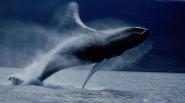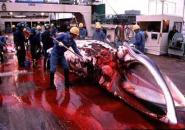Facts and figures

The global whaling industry has driven one whale population after another towards extinctionThe statistics say it all. The blue whales of the Antarctic are at less than one per cent of their original abundance, despite 40 years of complete protection. Some populations of whales are recovering but some are not.
Only one population, the East Pacific grey whale, is thought to have recovered to its original abundance, but the closely related West Pacific grey whale population is the most endangered in the world. It hovers on the edge of extinction with just over 100 remaining.
Recent DNA evidence shows that the impact of commercial whaling may be even worse than previously thought.
Most estimates of historic whale population size have been extrapolated from old whaling figures, but this method is often very inaccurate, according to marine biologist Steve Palumbi of Stanford University's Hopkins Marine Station in California, USA.
In 2003 Palumbi and his colleagues used DNA samples to estimate that humpback whales could have numbered 1.5 million prior to the onset of commercial whaling in the 1800s.
That number dwarfs the figure of 100,000 previously accepted by the IWC based on 19th century whaling records. Humpback whales currently number only 20,000.
Japanese delegates to the International Whaling Commission (IWC) constantly refer to a 1990 estimate of the Antarctic minke population of 760,000. But that figure was withdrawn by the IWC in 2000 because recent surveys found far fewer minkes than the older ones.
The new estimates are half the old in every area that has been resurveyed. The IWC's scientists do not understand the reasons for this and so far have not been able to agree a new estimate.
Consumption, contamination, catastrophe
 Whaling is no longer the only threat to whales. The oceans, or rather, human impacts on the oceans, have changed dramatically over the half-century since whales have been protected.
Whaling is no longer the only threat to whales. The oceans, or rather, human impacts on the oceans, have changed dramatically over the half-century since whales have been protected.
Known environmental threats to whales include global warming, pollution, overfishing, ozone depletion, noise such as sonar weaponry, and ship strikes. Industrial fishing threatens the food supply of whales and also puts whales at risk of entanglement in fishing gear.
If you're thinking of eating whale, you might want to think again - the blubber of dead whales in some areas is so highly contaminated with organochlorines such as PCBs and pesticides that it would be classified as toxic waste!
Organochlorines are known to damage development of children and affect reproduction.
Despite these accumulating threats, an increasing number of nations in the IWC voting for an immediate resumption of commercial whaling. Some new and enthusiastic members of the IWC include Benin, Gabon, Tuvalu and Nauru.
Obviously, these new memberships and voting numbers do not reflect a change in world opinion. These countries have all been recruited to join the IWC and vote under what is termed a "vote consolidation program" by the Fisheries Agency of Japan.
Great expectations
Expectations for the recovery of whale populations have been based on the assumption that, except for commercial whaling, their place in the oceans is as secure as it was a hundred years ago.
Sadly, this assumption is no longer valid. This is why we believe that commercial whaling in all forms must be stopped.

